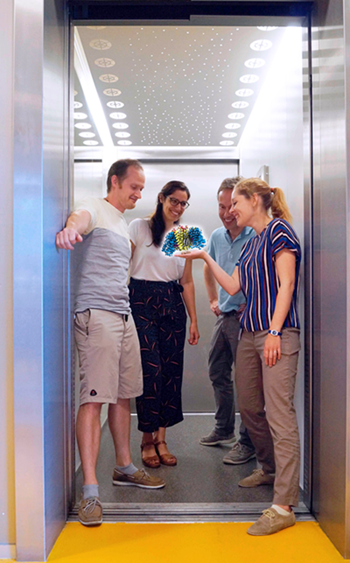Closing the door: breaking new ground related to a potential anticancer drug target
In order to sustain fast growth, cancer cells need to take up nutrients at a faster rate than healthy cells. The human glutamine transporter ASCT2 allows the amino acid glutamine to enter cells and is upregulated in many types of cancer cells, which need more glutamine. It is a potential target for new anti-cancer drugs. Researchers at the University of Groningen have now elucidated a structure of the human ASCT2 that provides unprecedented insight in the workings of this protein, and may help the development of drugs. The results were published in Nature Communications on July 31, 2019.

This work allowed the researchers to solve a long-lasting riddle. It was known that these transporters work like an elevator, where the substrate glutamine is engulfed by the protein, and then carried over a long distance through the cell membrane from the outside to the inside of the cell. While it was known how the substrate enters the elevator on the outside, it remained enigmatic what happens on the inside. This study now shows for the first time how the transported glutamine is released into the cytoplasm of the cell. The release mechanism is surprisingly similar to its catch mechanism on the outside of the cell. The same gate - a.k.a. elevator door - is used on either side of the membrane. “Hence, we have named the transport mechanism a ‘one-gate elevator’, which sets it apart from the more commonly observed mechanisms that use two different gates for entry and release”, Dr. Dirk Slotboom says.

Dr. Cristina Paulino: “This observation is of great fundamental interest, but also has potential implications for drug design. A prominent consequence of the one-gate elevator mechanism is that large protein movements take place in the cell membrane during transport.”
Therefore, lipids (the molecules of which the cell membrane is built) are likely to affect the workings of the protein. Indeed, the authors find many lipid-like molecules associated with the protein, where they occupy cavities on the surface. As these cavities have to be vacated for the elevator to move, small molecules that bind tightly to these sites might have drug-like properties.
Future studies will focus on the hunt for, and characterization of such molecules, which may lead to the development of new anti-cancer drugs in the nearby future.
Reference
Nature Communications ‘A one-gate elevator mechanism for the human neutral amino acid transporter ASCT2’, by Alisa A. Garaeva, Albert Guskov, Dirk J. Slotboom and Cristina Paulino – https://www.nature.com/articles/s41467-019-11363-x
In 2013 we published the article The Mystery of the Empty Lift.
More news
-
11 December 2025
Stormy planets and an unexpected atmosphere
-
09 December 2025
Faculty of Impact Grant for new brain cancer treatment
